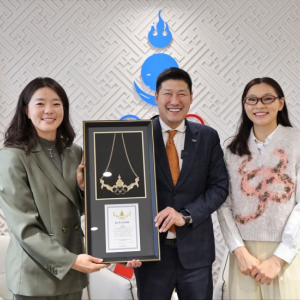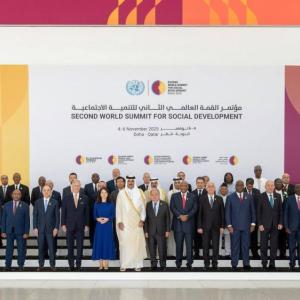Climate financing in Mongolia
The Mongol Messenger
In May, 2017, Mongolian commercial bank “Xacbank” received 500’000 dollars’ grant from Green Climate Fund. It was the first phase of GCF’s 20 million dollar contribution to reduce carbon emission rates in Mongolia. Mongolia’s capital Ulaanbaatar is one of the world's most polluted cities, mainly because of coal-fired power plants, and coal-fueled stoves and boilers which are used to heat homes in this world's coldest national capital. Even though the pollutants in the air is estimated to be 8 times the world standard, Government of Mongolia is too busy dealing with the financial crisis to take actions against it. GCF’s grant could bring major positive changes as it would kick start the biggest climate program with 60 million USD budget. Only 0.07 percent of the national budget goes to the Ministry of Environment and Green Development. Thus, climate projects are in serious need of financing, and that 500’000 USD might have come in just the right time.
Mongolia is known by its vast, beautiful landscapes, wonderful solitudes, and the rich hospitality of nomads. Sadly, the landscape changed drastically due to the sudden increase of mining business. Almost half of the domestic budget comes from coal exports and it doesn’t seem to change in the near future. The biggest attempt to turn into sustainable energy resources are mostly invested by the private sector. Mongolian economy is solely dependent on their export of mining products and income rates shown below illustrates how much Mongolia is in need of an economic support to overcome the challenge.


Corruption
Efficient investment with safe monitoring is crucial when it comes to Mongolia. The reason hardly any foreign investor approaches Mongolia is corruption. To make sure the funding is going to places they intended to, international organizations tends to directly connect with private sectors rather than government officials. Recent events such as partnership with Xacbank proves it as well. But the fact that there are very few corporations big enough to run the financial grant also puts this option at risk. Therefore, careful partnership with the Government with strict monitoring, or funding the private sector to support low-carbon energy sector seems to be two most suitable choices.
Tight provincial budgets
Despite the fact that all protected landscapes are in the hands of local governments, the state always puts major restraints on provincial budgets. Tight budgets put those local governments in position to issue more mining licenses in order to create their own reserves. They have even started granting mineral exploration licenses after banning it for 5 years due to negative environmental impacts. More mining means more CO2 will be released into the atmosphere, thus, to efficiently finance the climate change mitigation; strong local budgets must be constructed firsthand.
Private sector investment
Mongolia’s first wind farm was built and funded by Newcom LLC and Clean energy LLC, both are private companies. They are currently funding another major sustainable energy project, which is to build the first solar energy plant. Hopefully, other private sectors might take more interest in low-carbon energy sector now that the Xacbank is providing low interest loans. Judging from these facts, it seems that private sectors are pioneering the way towards more climate-friendly Mongolia.
Problems we are facing do not end here. In fact, there are even more problems involving the mining boom Mongolia experienced during the last decade. Mining companies execute land rehabilitation poorly, or not at all; because there is a legal way to make small contribution to local government’s fund rather than constructing rehabilitation. Law makers must reconsider such ways that offer big corporations a way out.
Sustainable energy, responsible mining and strong will to bring positive changes are the things we must do to keep our country as stunning as it has been through the history. Mongolians have worshipped nature for as long as they existed and that love can be the source of motivation to do what is right.
Mongolia is known by its vast, beautiful landscapes, wonderful solitudes, and the rich hospitality of nomads. Sadly, the landscape changed drastically due to the sudden increase of mining business. Almost half of the domestic budget comes from coal exports and it doesn’t seem to change in the near future. The biggest attempt to turn into sustainable energy resources are mostly invested by the private sector. Mongolian economy is solely dependent on their export of mining products and income rates shown below illustrates how much Mongolia is in need of an economic support to overcome the challenge.


Corruption
Efficient investment with safe monitoring is crucial when it comes to Mongolia. The reason hardly any foreign investor approaches Mongolia is corruption. To make sure the funding is going to places they intended to, international organizations tends to directly connect with private sectors rather than government officials. Recent events such as partnership with Xacbank proves it as well. But the fact that there are very few corporations big enough to run the financial grant also puts this option at risk. Therefore, careful partnership with the Government with strict monitoring, or funding the private sector to support low-carbon energy sector seems to be two most suitable choices.
Tight provincial budgets
Despite the fact that all protected landscapes are in the hands of local governments, the state always puts major restraints on provincial budgets. Tight budgets put those local governments in position to issue more mining licenses in order to create their own reserves. They have even started granting mineral exploration licenses after banning it for 5 years due to negative environmental impacts. More mining means more CO2 will be released into the atmosphere, thus, to efficiently finance the climate change mitigation; strong local budgets must be constructed firsthand.
Private sector investment
Mongolia’s first wind farm was built and funded by Newcom LLC and Clean energy LLC, both are private companies. They are currently funding another major sustainable energy project, which is to build the first solar energy plant. Hopefully, other private sectors might take more interest in low-carbon energy sector now that the Xacbank is providing low interest loans. Judging from these facts, it seems that private sectors are pioneering the way towards more climate-friendly Mongolia.
Problems we are facing do not end here. In fact, there are even more problems involving the mining boom Mongolia experienced during the last decade. Mining companies execute land rehabilitation poorly, or not at all; because there is a legal way to make small contribution to local government’s fund rather than constructing rehabilitation. Law makers must reconsider such ways that offer big corporations a way out.
Sustainable energy, responsible mining and strong will to bring positive changes are the things we must do to keep our country as stunning as it has been through the history. Mongolians have worshipped nature for as long as they existed and that love can be the source of motivation to do what is right.
By Tushigjargal Bold
 Ulaanbaatar
Ulaanbaatar













































































